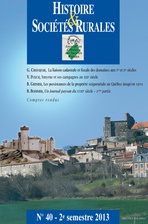RHN 9/2014 | Publication
Contents:
La liaison cadastrale et fiscale des domaines d’après les tables alimentaires et les textes gromatiques aux Ier et IIe siècles
/ The cadastral and fiscal linking of landed estates according to the alimentary tables and the gromatic writings of the 1st and 2nd century A.D
Gérard Chouquer
pp. 7-33
Abstract: This paper analyzes the way landed estates in Roman Antiquity were consolidated for fiscal reasons, on the basis of the cadastral census. This linking technique was called the estate contributio and was outlined in a passage of the De Controversiis Agrorum written by Hygin, a land-surveyor. A spectacular illustration of this method is provided, in the same period in which Hygin’s text was written, by the way the alimentary tables from Italy consolidated estates under cadastral and fiscal call numbers, so as to determine a list of leaseholds, called obligatio praediorum (estate pledging). This cadastral and fiscal approach is analyzed in detail through the most explicit table available, that of Veleia, in the Piacenza Appenines. Through the technical understanding of this leasing procedure, we come closer to grasping the true meaning of terms such as fundus and villa in this kind of source, and conclude to a plurality of meanings.
Smyrne et ses campagnes au XIIIe siècle. Les relations d’une ville byzantine avec son arrière-pays / Smyrna and its countryside in the 13th century
Vincent Puech
pp. 35-59
Abstract: Little is known of the relationships between provincial Byzantine cities and their hinterlands. However, the archival funds from Athos allow for some progress on the issue when it comes to Macedonian cities, Thessaloniki in particular. Through the Roman and Ottoman periods, Smyrna, Izmir today, was a city with a commercial activity widely attested in sources at the times, enough for us to have some idea of its supplies. Indeed the best documentation on the Smyrna area concerns the 13th century. At that time, the imperial power was residing close by, and protected the Lembiotissa Monastery, the cartulary of which has been conserved. The deeds it contains provide us with an opportunity to discover some traits of the social relationships between the city of Smyrna and its surrounding countryside. The city included a number of agricultural lots. City-dwellers owned property in the country, and large country landholders also invested in the city. The case of Smyrna thus shows that both the provincial town and its countryside were inserted in the same common social structure, placed under the control of the Byzantine state.
Les persistances de la propriété seigneuriale au Québec. Les conséquences d’une abolition partielle et progressive (1854-1970) / The permanence of seigniorial landownership in Quebec
Benoît Grenier
avec la collaboration de Michel Morissette
pp. 61-96
Abstract: The seignory was introduced in New France as early as the 17th century, and dominated the process of territorial colonization in the Saint Lawrence valley. The seignorial institution survived the English conquest, and was officially extinguished only in December 1854, through a legislative act. The present paper aims at demonstrating that the abolition of the seignorial regime actually took place only gradually, and only in part. The act whereby the feudal rights and duties in Lower Canada were abolished is usually seen as theoretically ending the history of the seigniory in Quebec ; here, we analyze it as the starting point of a slow process aiming at extinguishing seignorial rents, and which was completed only in 1970. In a first part, we show how the 1854 law came to buttress the legitimacy of the seignorial rights, and provided the landlords with guaranteed compensations which had a lasting effect on the Quebecois peasantry. The latter went on paying rents according to modalities similar to the ones existing before abolition. In a second part, we bring to light the extent to which these rents were still in place on the eve of the Second World War, and we explain how, when the State of Quebec intervened to put and end to the relation between the seignior and its censitaire tenant, it did so with the same goal to « fairly » compensate landlords. Lastly, we conclude with an analysis of the evolution of the group formed by the « last landlords of Quebec » from 1854 to 1940.
Un journal paysan du XVIIIe siècle. Le livre de recettes et dépenses de François Jacques Maret laboureur et vigneron à Bueil (Eure), de 1730 à 1761. 1ère partie / A peasant diary in the 18th century
Bernard Bodinier
pp. 97-154
Abstract: Few diaries were written by peasants, especially in the Old Regime, so that publishing one is always worthwhile. The diary we consider here was written, not by a member of the farming elite, but by a multi-active yeoman farmer (laboureur), one of many such peasants living in Upper Normandy in the 18th century. François Jacques Maret resided in Bueil, in the Eure valley, and was concurrently farmer, winegrower, sheep fattener, etc. He scrupulously took note of his business transactions in what was really an accounting waste book covering thirty years of his life. This source gives us elements on harvests and their sales (particularly sales of wine, but also of fish), and on the acquisition and sale of animals, primarily sheep, which became a crucial preoccupation of our diarist. The account also reveals the terms and modalities of payments, whether the disbursements concerned the wages of servants or day laborers, or the settlement of market transactions in which Maret was involved, as buyer, seller, or sometimes borrower...
View the full table of contents and abstracts here: www.cairn.info
Source: www.cairn.info
